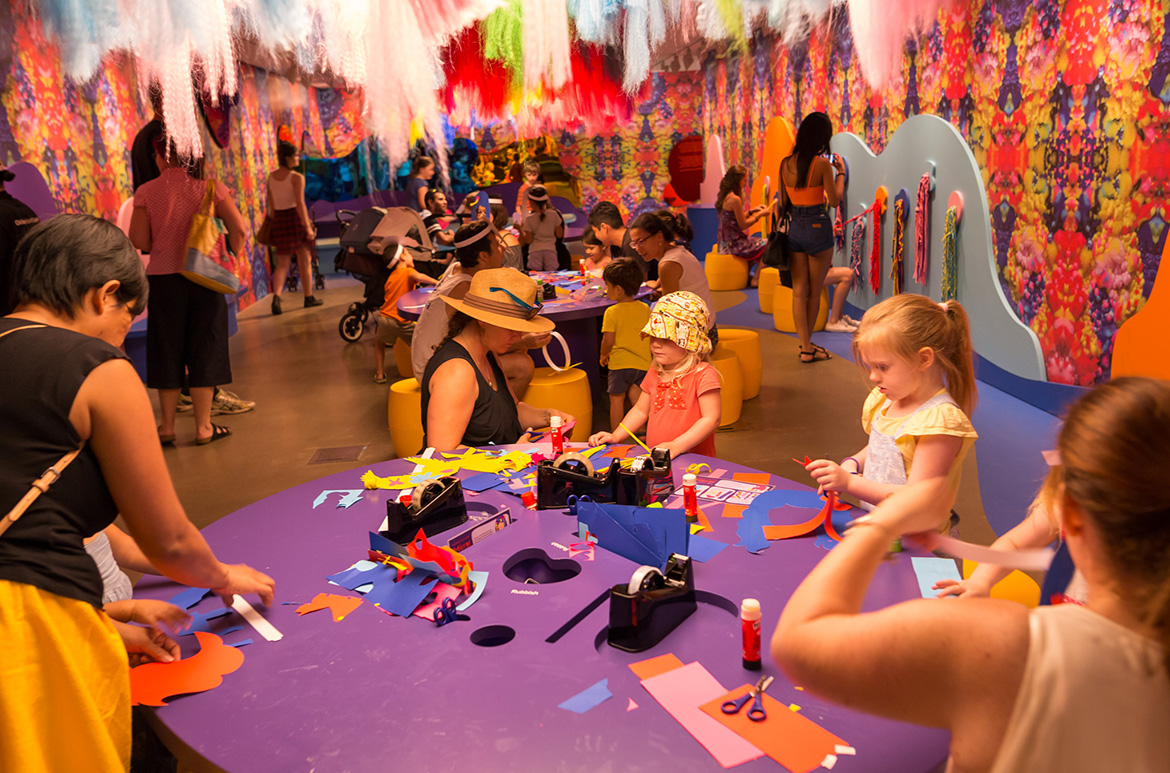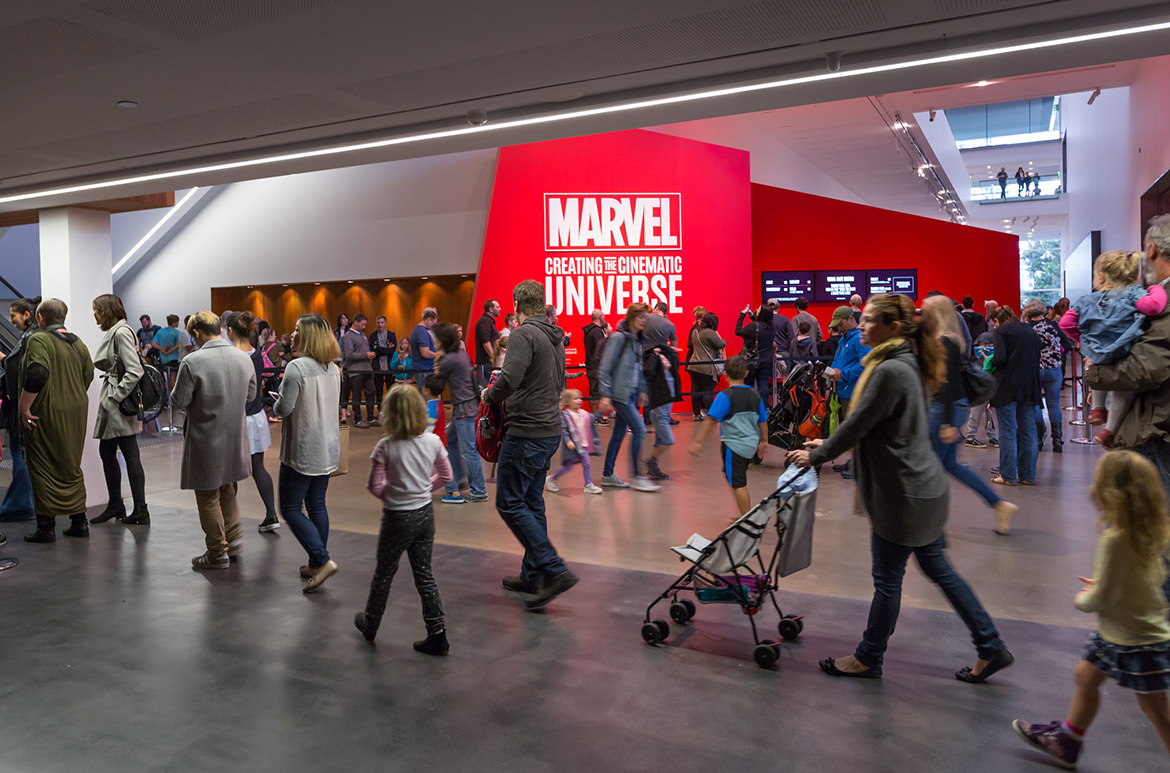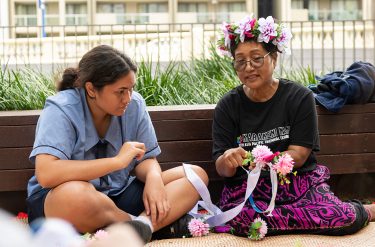For people with autism or sensory sensitivities, visiting an art gallery can be challenging, especially during blockbuster exhibitions where crowds, colour, sound, light and movement abound, we explore how low sensory viewings help visitors with autism spectrum disorder or sensory sensitivities to engage with visual art, amid a general push worldwide towards cultural institutions making their programs more accessible to people with disability.
Low-Sensory exhibition viewings
In the summer of 2017, when GOMA Turns 10 celebrations were in full swing with ‘Sugar Spin: you, me, art and everything’, the Gallery received an inquiry from a young mother of four girls, three of whom had autism spectrum disorder (ASD). The gallery environment presented unique challenges for her daughters, she explained, and their visits were often cut short due to sensory sensitivities. The description of ‘Sugar Spin’ as ‘an explosion of colour, sensation and spinning delights’ made her hesitate: as much as the family loved visiting QAGOMA, the scale and nature of the displays, coupled with the likelihood of crowds and loud noise, were often a barrier.
READ MORE: Art and Dementia Tours


Related: Watch as we install Hrafnhildur Arnardóttir’s ‘Nervescape V’
On this occasion, not wanting the family to miss out, the Gallery arranged for a weekend visit before opening hours to allow them to enjoy the exhibition in a quieter and more relaxed setting. Determined to improve future experiences for visitors with ASD and sensory sensitivity, however, the Gallery’s Access team (under the umbrella of QAGOMA Learning) initiated plans for a low-sensory experience of the ‘Marvel: Creating the Cinematic Universe’ exhibition, which opened at GOMA in May that same year. To help design the experience, Kathleen Davey, a clinical psychologist from Decipher Zone and the Social Skills Training Institute at the Autism Cooperative Research Centre (Autism CRC), walked through the Marvel exhibition with QAGOMA staff and several young adults with ASD to look at ways that the Gallery could reduce sensory stimulation. On the day of the low-sensory viewing, audio in the exhibition spaces was lowered or turned off and a number of areas became designated quiet zones. A pre-visit information pack included a written information sheet telling visitors what to expect, as well as a tailored floor plan highlighting high-sensory areas. Feedback was overwhelmingly positive from the 170 people who attended.

Related: Go behind-the-scenes as we install Marvel costumes
Low-sensory viewings have since become part of the schedule for major exhibitions, and members of the ASD community have been invaluable in helping shape these viewings. While ASD affects people in different ways, many people on the autism spectrum have difficulty processing everyday sensory information. Any of the senses may be over or under-sensitive (or both, at different times), and too much sensory information can cause stress, anxiety and possibly physical pain. In the context of an art gallery, for example, those who are over-sensitive to visual stimulus may find that objects and bright lights appear to jump around, images may fragment, and it may be easier and more pleasurable to focus on a detail rather than on a whole artwork. Sound can also be magnified, distorted or muddled, and it can be difficult to filter out background noise. Therefore a low-sensory approach — which the whole of QAGOMA adopted on 2 April 2019 in support of World Autism Awareness Day — enables visitors with ASD to experience a quieter, more relaxed environment to view exhibitions. Increasingly, museums and galleries worldwide are developing programs to make their exhibitions more accessible to people on the autism spectrum.

Related: Anne Noble introduces Conversatio: A cabinet of wonder
In February 2019, Nichole Conolly joined the QAGOMA Learning team as a volunteer after the Autism CRC Future Leaders Program approached the Gallery about possible placements for young adults with autism. Nichole aims to complete her Certificate IV in Education Support this year, and, coupled with her Graduate Certificate in Autism Studies, hopes to work with autistic individuals within the education and performing arts communities. ‘I would like to see everyone receive the education they deserve, together with understanding teachers and support staff’, she says.
Nichole became interested in the arts as a child, and from a young age she was encouraged by her parents in a variety of extracurricular activities. ‘Arts quickly became a passion for me and at times an escape’, she explains. ‘Everyone in the arts community is a little different, so I don’t feel like I stand out — I feel very at home.’ When asked about her experience, as someone with autism, of visiting art institutions like QAGOMA, Nichole says that she likes immersing herself in artwork that she may not have seen before: ‘I enjoy art that makes me think. Some of the challenges can include the visual and auditory overloads, but I overcome this by wearing [sun]glasses and headphones.’
Through her volunteer experience, Nichole hopes to gain not only a greater appreciation for art but also a feeling of achievement from helping to make QAGOMA a more inclusive environment that everyone can enjoy.
I have many passions in life, but one of the biggest is to help others. I love the feeling I get when someone achieves something that they have worked hard for. I have a dream to help autistic adults and children overcome everyday barriers and be the best they can be.
Helen Bovey is Program Officer (Access), QAGOMA
Know Brisbane through the QAGOMA Collection / Delve into our Queensland Stories / Read more about Australian Art / Subscribe to QAGOMA YouTube to go behind-the-scenes
Feature image: ‘Sugar Spin: you, me, art and everything’, at GOMA in 2016, included many artworks and installations that were high-sensory in nature / Photograph: Mark Sherwood
#QAGOMA


